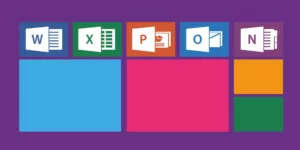By mid 2018, you can expect to see a rollout of updates to the 2019 Microsoft Office suite of applications, including Excel, Word, PowerPoint, and Outlook.
Office 2019 is mainly for companies and organizations that aren’t using the cloud version, Office 365. Of course cloud innovation is still a major topic of conversation, but Office 2019 offers upgrades for customers who want to keep their applications and servers on-site.
For people who frequently use Excel and PowerPoint, the changes are especially exciting.
“Office 2019 will add new user and IT capabilities for customers who aren’t yet ready for the cloud,” according to a Microsoft blog post. “For example, new and improved inking features—like pressure sensitivity, tilt effects, and ink replay—will allow you to work more naturally. New formulas and charts will make data analysis for Excel more powerful. Visual animation features—like Morph and Zoom—will add polish to PowerPoint presentations. Server enhancements will include updates to IT manageability, usability, voice, and security.”
As is, a product like PowerPoint is a pretty amazing sales tool. It’s intuitive and visual but also technical. You can use charts, numbers, pictures and lists in a simple or complex manner depending on the topic and your audience. You can take one basic topic and tailor it to different groups, whether it’s co-workers, customers or engineers. Any improvements to PowerPoint will only add to what the product already does.
Microsoft’s announcement of its new Office suite in late September isn’t packed with too much detail, just enough to tease customers of what they can expect when it’s officially released in 2018. Part of the redesign includes simplifying the user interface for Outlook on both the Mac and Windows versions.
“Reducing complexity is one of the key aims of the redesign, to make it easier for new and existing Outlook users to navigate the email,” explains The Verge writer Tom Warren.
Interestingly, as Technodite previously reported on Nov. 1, Microsoft announced the abandonment of its Outlook Premium offer for Office 365 because of what they deemed an unsuitable messaging platform.
Microsoft plans to share more about its Office 2019 product in the coming months. For now, though, it appears that if you’re an Office 365 user you’ll continue to have the most up-to-date features.
So, what are the advantages of continuing with Office, now that Office Suite (365) and Microsoft Surface have broken into the cloud market?
Well, some people just aren’t on board with the cloud yet, so Microsoft wants those customers to know they have not been overlooked. Office 2019 is an upgrade for people who still feel the need to keep their apps and servers on their premises.
Even if a person isn’t scared of the cloud, some customers just want to pay a one-time fee for the stand alone software, not the yearly subscription that’s required for Office 365. It’s unknown what the cost for Office 2019 will be, however.
The Office 365 bundle could be the way to go for savvy users who need multiple applications and sharing files and documents, but most people don’t need the beefiness that 365 offers because they aren’t taking full advantage of its capabilities. There’s more to Office 365 than email, file storage and access to Office programs, so you may be paying for more than what you need.
Whether you’re a cloud-based fan or just would rather pay for the stand alone products, Microsoft never ceases to up their game and get people excited for the future in tech.








